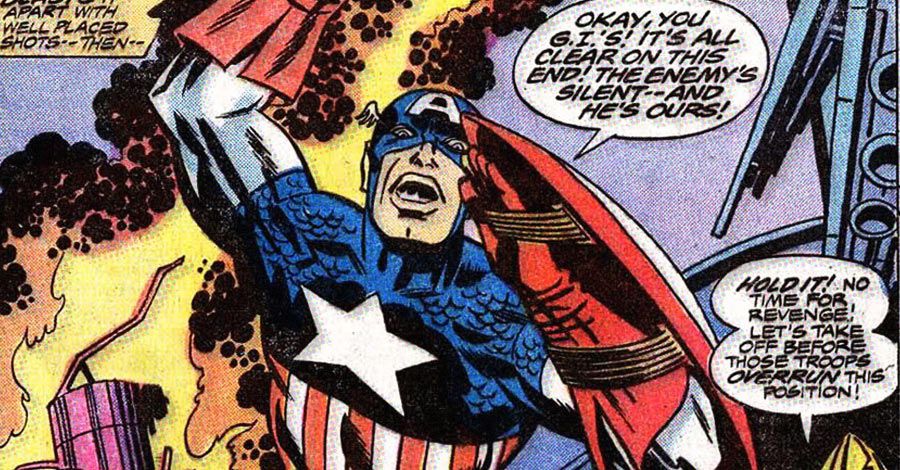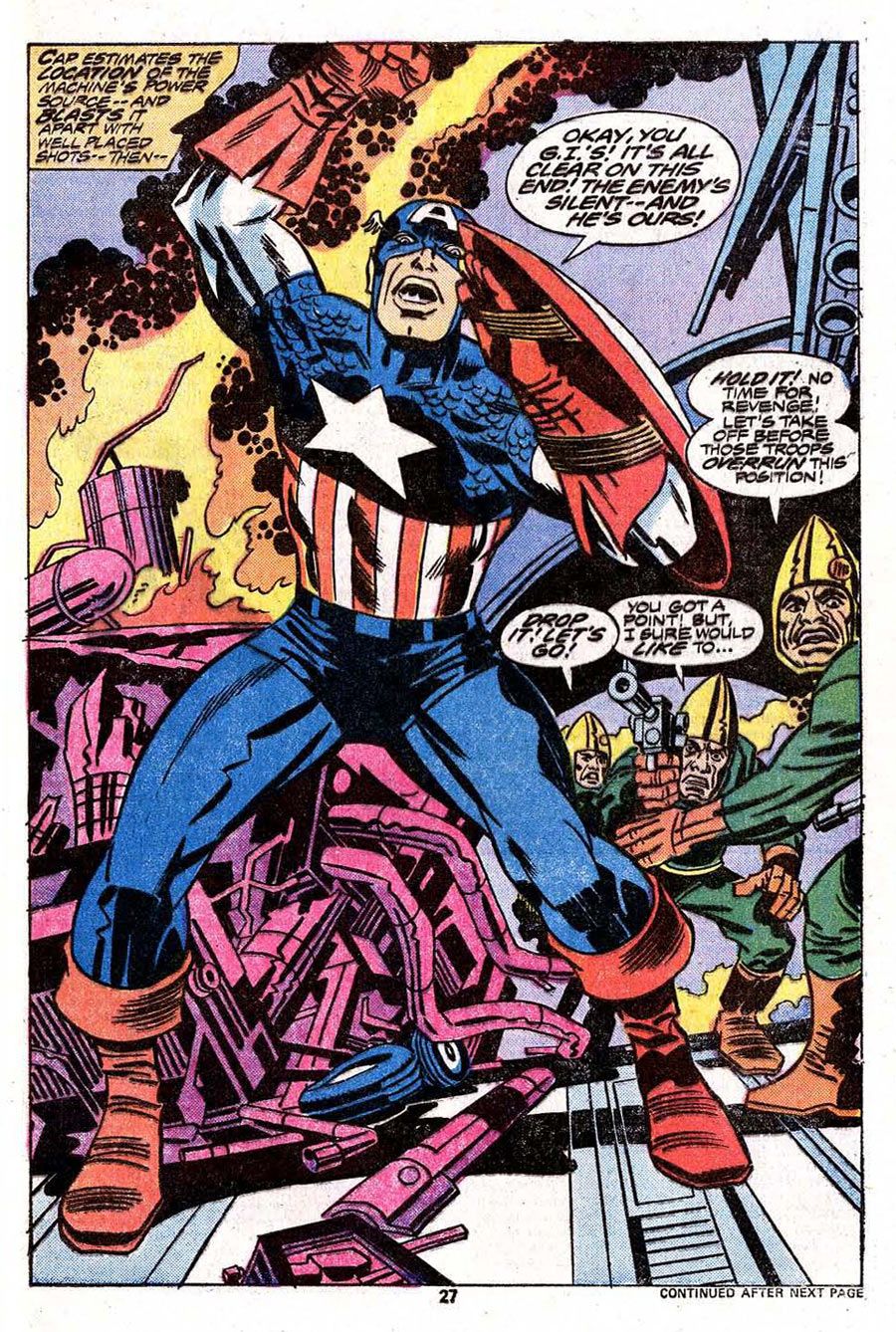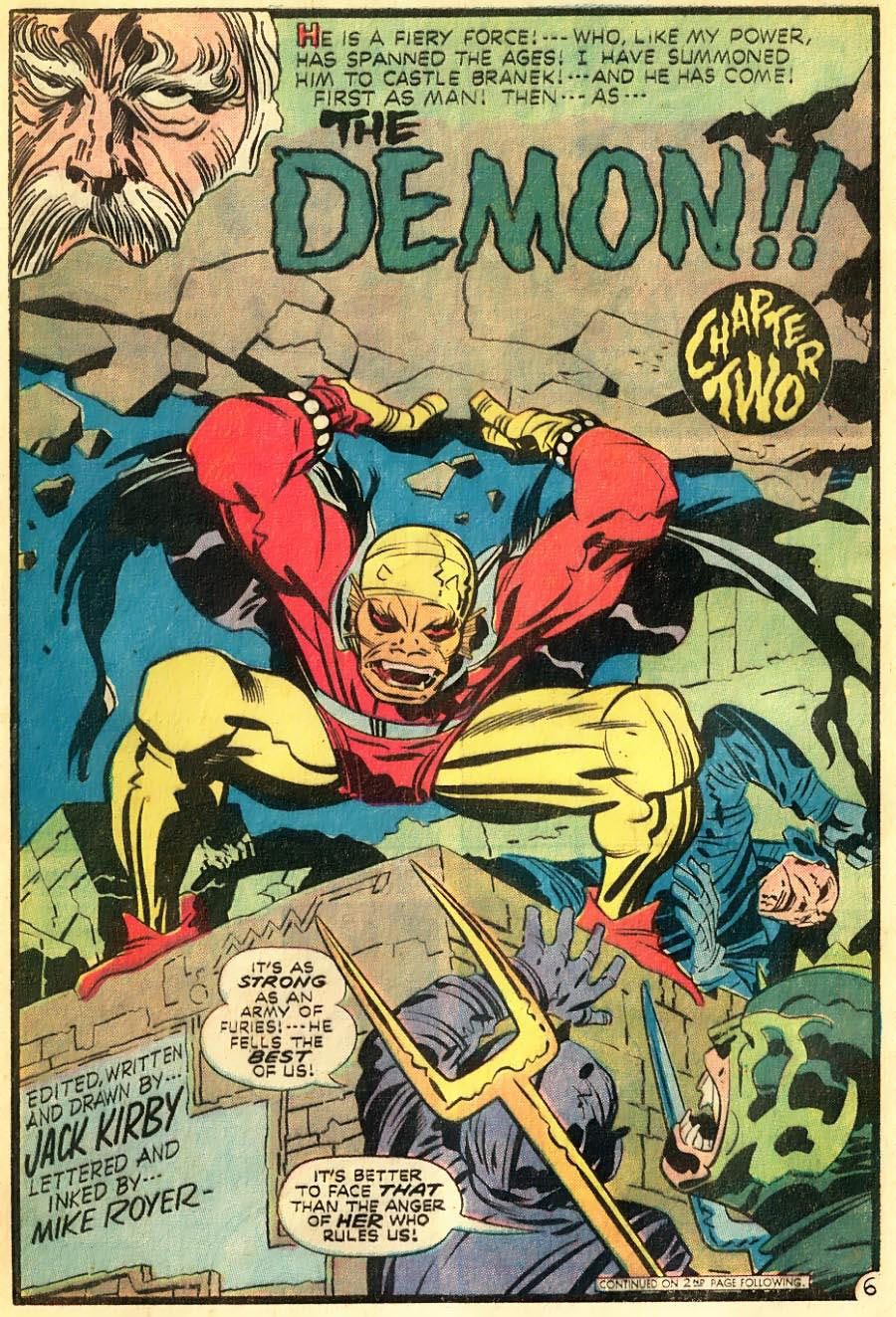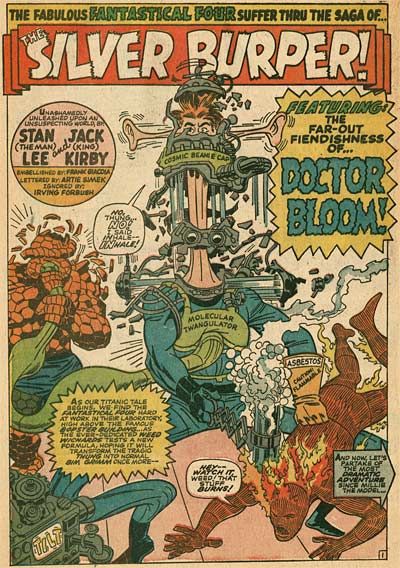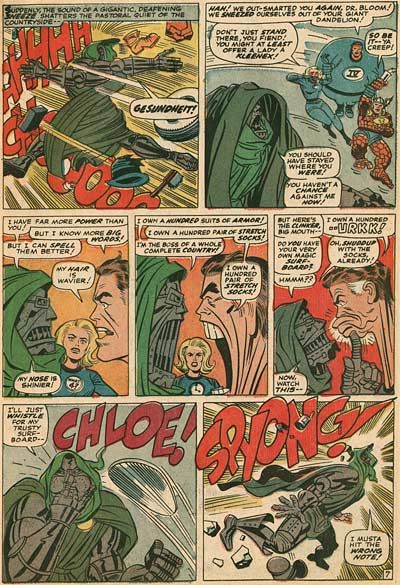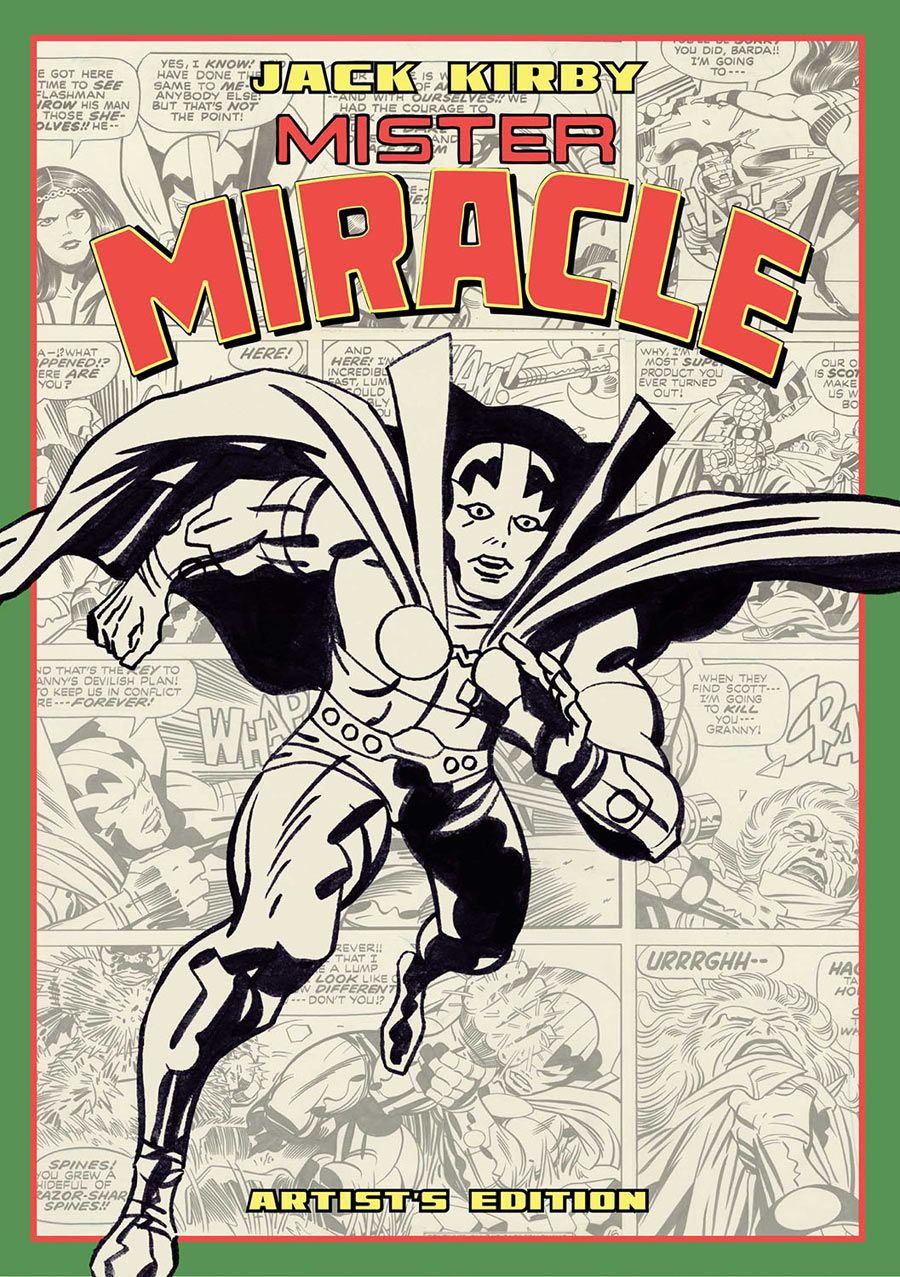In a small room just off the first floor's main hall, a handful of dedicated fans came together at New York Comic Con to celebrate the life and creations of the legendary Jack Kirby. Led by Kirby Museum founder Rand Hoppe, artist Guy Dorian ("COR"), and artist Erik Larsen ("Savage Dragon"), the panel looked at the way Kirby has inspired generation after generation of comic book fans. Although Walt Simonson was slated to attend, he was unable to make the panel due to traffic.
When the panel kicked off, Hoppe was the only panelist in attendance. While he waited for his co-speakers to arrive, he chatted a little about his Kirby Museum projects from the past year. "We had a pop up [display] on the Lower East side last year, which was a huge success," he recounted. "[We've] spent a lot of time online, getting artwork out, dealing with queries from scholars, researchers."
He also touched upon what membership with the Kirby Museum entails: "A lot our membership dues help to pay for convention booths and stuff like that, so if you're interested, please help us out, become a member, volunteer, we need all the help we can get!"
Touching on the recent legal settlement, Hoppe said, "Obviously there's been a sea change in the world of Kirby, where the Kirby family is now very happy about Marvel, and Marvel is very happy about the Kirby family. And guess what? I have nothing else to say about that! That's all I know! They're happy, so I'm happy!"
"Something that I'm telling a lot of people is that now, since [Kirby's] 100th birthday is coming up in 2017 -- and we've known about that obviously, and we're building towards that... I just feel a little bit better about trying to get a postage stamp for Jack," he announced to a round of applause. "Why have a Jack Kirby postage stamp if the family is a little uncomfortable about 'The Fantastic Four' or something? So... it's all good news. It's just great that that era has passed. There's been projects that I wouldn't have minded doing, or people that I wouldn't have minded talking to, but just because that legal stuff was going on, it kind of just put a damper on things. Now it's a little bit like the chains are off, and we can start talking to different people about sponsorships or any kind of support for the Museum.
"One exciting piece of news!" he continued. "We're helping an exhibit that's going to be at Angouleme in January, so there's going to be a Jack Kirby exhibit at the largest European comic festival... Once it's done (the festival runs 4 days, kind of like this) this particular show... will package it up and they're going to offer it as a travelling exhibit, so it may end up in Prague or Denmark or Germany... Jack's work is going to get around."
Hoppe also spoke about another service that the Kirby Museum has offered: "Since 2006, we've been scanning Jack Kirby original art. We have probably 5000 pages of his art scanned in our digital archive... up until maybe a year and a half ago, we actually had a special section on our website that allowed people who became members of the Museum to have special access... We took it down, and Tom Kraft -- trustee of value, volunteer for the Kirby Museum -- puts in maybe even more time than I do [and] he's developing a new collections website, so we're going to have a whole other section of collections... There will be a special membership section." The Kirby Museum membership costs $40 a year.
He switched topics to recollect his first encounter with Kirby's work, saying, "I was a big 'MAD Magazine' fan, I read 'Peanuts,' comics, and paperbacks, and I was at summer camp -- I was 12 years old -- and I read a story about a kid in the future with animals... It kind of blew my mind and I learned who Jack Kirby was that day... My buddy goes, 'Oh, that's by Jack Kirby. All those other comics that you just read? He created every character in there.' That's my origin story."
At this point, Dorian and Larsen -- co-founders of the "Jack Kirby!" Facebook group) joined Hoppe on stage. "What's your origin story?" Dorian asked Larsen.
"My dad read comics when he was a kid," Larsen responded immediately, "so I grew up with his comics. My first Jack Kirby comic was 'Boy Commandos.' When I first discovered Jack... he was on at DC Comics, so that was my real gateway drug into modern Jack Kirby comics."
"Mine was either 'Fantastic Four' or 'Captain America,'" Dorian divulged, "I remember seeing a picture of the Thing, I don't remember what cover it was, and I was just like, 'That's the coolest damn thing that I ever saw...' I guess I was like 8 or 9 when I saw that."
"How old were you when you first [read Kirby]?" Dorian inquired of the other two panelists.
"I was late," Hoppe admitted, "I was 12."
"I was probably 10," Larsen answered. "My dad gave us his comics when we were way too young and we just wrecked them. My brother would wake up with a comic book wrapped around his face when he fell asleep reading. It was bad news, so he took them away from us for a while and then gave them back."
"I think Galactus and Silver Surfer... just brought me in," Dorian explained. "That right there, the imagery! It just blew my mind right there."
"The power! The scope!" Larsen agreed. "His ability to just do seemingly anything. There are so many artists who have done comics over the years and so many of us have severe limitations... Jack's like, 'Romance? Boom, done. Westerns? Boom, done.'"
"Whether it was war or romance or anything or crime," Dorian added, "Jack was so good, even back then, but his whole style was totally different. He came from comic strips."
Hoppe then took Dorian's point and provided some historical context for it: "[Kirby] came from strips and the newspaper strips were the goal. That was... where guys wanted to work if they were comic artists; that was the fancy job. At the time, comic books were kind of the ghetto. You work there because you wanted to make a living... But one of the things that someone like Will Eisner and Jack and Joe Simon did was to actually treat the comic book form -- which was a comic story told over pages -- and treat that as a new art form, as a new way to tell stories, which hadn't been done at that point because they hadn't been printed that way."
"There's like nothing really in comics that he hasn't done, other than porn," Larsen agreed.
"Everyone in here should walk out of the room knowing that Jack was a creator first," Dorian enthused, as the other two panelists nodded in agreement. "And he's still creating today! I'll tell you why: Because every time one of us artists take a character that he had worked on or done or been involved in... he influenced everyone."
"He either influenced everybody, or he influenced guys who influenced somebody else," Larsen said. "Even guys sitting there going, 'Oh, maybe Mike Mignola [influenced me]!' Well, guess where that came from? Without Jack Kirby, without the Demon, there is no Hellboy... Take him out of the equation, it's gone."
"The first comic book was reprinting comic strips," Larsen explained. "The format of them was there would be 4 tiers because that's how many comic stirps would fit onto a page. Originally, 'Superman' was pitched as a comic strip and was drawn in that 4-tier format. So, when guys came on and were doing comic books, it was all about 4-tiers, it was all about emulating the look of reprinted comics... What eventually happened is that they figured out 'oh we can do all this other stuff' that you couldn't do in that 4-tier format. It eventually became fairly common to do a 3-tier format which opened up the panels a lot more and was able to give you a whole big square rather than a tiny little thing. And they just went wild with it. They were able to go, 'Well, okay we can do a full page and we can do 2 pages spread...' and that just opened up everything. There was no limit to anything you could do..."
"There's no way that any of Jack's art, even one panel, his work is contained in there," Dorian built upon Larsen's point. "Everything explodes past the panel everywhere... so Jack -- especially when he was writing -- he would put in these double-page splashes... You could sit there all day and just look at one picture, let alone everything."
Larsen added, "We find all sorts of people who have original art and they scan that in and they'll send it to us and we'll put that up [on our Facebook page], so you go to the double-page spread thing and it's like, 'Here's from a comic book all scanned in, here's the original art, here it is cleaned up' and guys will be like, 'I did a 3D version!'... It's great, because everybody is kind of contributing and wants this to be this wonderful community."
"Jack could work from a script, or he could work not from a script," Dorian said. "You could tell Jack what to do, but really, you never had to tell Jack what to do. Jack would just create it. He would come up with it, he would write and draw it."
"The Marvel method, as it developed, was that Stan was supposed to be writing all the books," Larsen said. "There was a bunch of different artists, everyone needed to be kept busy, and it wasn't always possible... for him to write a full script to give to all the artists to keep everybody busy... He developed this method where he would come in with the artist, they would have a discussion in the room, and the artist would take notes and they would leave and they would go home and they would draw the comic and they would put margin notes on as to what happened... Then it would get back to Stan and Stan would script it -- or not!"
"Eventually, with Jack, it got to be to a point where there wasn't even barely a discussion," Larsen went on. "Stan would just say, 'Jack, go out and draw the Fantastic Four versus God' and then [Kirby] would come back with Galactus and the Silver Surfer and all this other stuff going on in the story. It would be like, 'Who the hell is this guy?'"
"Of course, Stan was running around doing a million [things]," Dorian pitched in. "He was basically a one-man army at the time, running around doing everything with a lot of artists. It worked out well."
"He worked with the best guys in the business," Larsen agreed. "Really incredible storytellers... sometimes it worked out really well, and sometimes once they weren't communicating, so, well, it kind of got a little screwy."
"He would give people chances to do it," Hoppe added. "And they weren't able to do it, or didn't want to work that way."
"A lot of times, too, Jack would end up doing very basic storytelling [and] breakdowns that would be handed to new artists," Larsen explained. "John Buscema's first job was going over Jack Kirby art, just his layouts. Same thing with John Romita, same thing with Jim Steranko."
"Some people think that Jack never ever... did a breakdown," Dorian added. "But he obviously did, because he also handed it to other people work off of."
"He did quite a few [pages] a day," Hoppe said.
"He did an issue over two days," Larsen responded.
"Who does that? That's insane!" Dorian exclaimed. "I think he did 15,000 pages in one year, one time, counting covers... That was at the peak of his career, think about that."
"The thing is," Larsen continued, "when he was doing 'The Fantastic Four' #1, he was 44 years old. He was not a kid. He had been doing this a while. Remember, he created Captain America in 1941, which was 20 years before that. So this was not a guy just starting out. This is a guy who is a veteran. When we think of Kirby's style, it's like he didn't even develop what we think of as being his style until he's into his 40s."
"Jack, if look at his old sketches," Dorian said, "he really understood people. The most important thing about telling a story is understanding characters and visual language, the motion and movement... and Jack could capture that. Most people know Jack from 'The Fantastic Four' and stuff like that... but, really, if you go back and you look at that stuff... he did pencil and ink at times. He could color. He knew what hatching was; he knew how to create tone. He knew how to create form."
"We all benefit from Jack Kirby," Dorian continued, "I mean, we're all sitting here right now and how long has he been gone? Think about that... and we have almost 6,000 people on Facebook... It actually goes into my regular life and then my wife hears about it... My daughter wound up doing her thesis project on Jack Kirby... the influence! Everyone here today will probably tweet or text or post something that they were here. Think about that. That's just here, in this room."
"All the art on my wall is Jack Kirby artwork," Larsen admitted. "It's not my own stuff, that's for damn sure!"
"If anyone hasn't seen the display upstairs for the Jack Kirby Museum," Dorian gushed, "there's giant pictures of Jack's work. Beautiful, beautiful work."
"All the hi-res scans we've been making," Hoppe clarified. "We've been printing out a number of hi-res prints. It looks like original art, but it's not!"
"IDW is doing a bunch of Kirby books," Larsen added. "The 'New Gods' one is the first of many. I don't know what they've announced, but I know stuff."
"In my head, for this moment for a second, what happened was this explosion of Jack Kirby," Dorian attempted to articulate, "You try to start somewhere, but it's like a circle mass of stuff, because he did so much stuff. [Hoppe] has a poster upstairs. How many characters?"
Hoppe shook his head. "I don't even know. It's called 'The Power Pack Marvel Art of Jack Kirby.' It's a collage made by a collage artist, Tom Morehouse. I scanned it in, 12 pieces, and printed it out as a very fancy, limited edition print... It's just filled with all of Jack's Marvel characters. You look at it and you say, 'Where did Marvel come from?'"
"And that's only from the '60s up!" Dorian said.
"I have a funny one!" Hoppe interjected. "Captain America got Jack and his family out of the ghetto. Romance comics got him and his family into the suburbs. Marvel Comics got him and his family out to California. And then unfortunately he left comics and went into animation. The animation helped him keep his house when he got sick. That's the milestones for his life."
"The biggest check he ever got was from us! Was from Image Comics," Larsen said. "Rob Liefeld and Eric Stephenson are going over and visiting Jack Kirby and looking through his drawers and went, 'What's this?! Oh my God! This has never been printed before! You've got to get the Image guys on this!' And we all donated our time and effort and worked on Jack's last book and put out 2 issues of 'Phantom Force.' All the proceeds went to the Kirby family, and that was the biggest check they'd ever seen in their lives."
"It wasn't just about a check," Dorian said.
"It was about respect," Larsen agreed. "This was a guy who influenced every one of us, pretty much everyone in the industry at this point."
"There really isn't one day... that I don't look at Jack Kirby's stuff," Dorian said. "Not one day. And I had a chance to meet him! I didn't go. I didn't meet him."
"I interviewed [Kirby] in '92," Hoppe recalled, "I was like 13 [when I first met him], I went to one of those conventions -- Creation Con -- he was sitting there, doing sketches for people, and my buddy and I kind of stood there and just watched him draw for like an hour and a half."
"That's the other thing about Jack," Dorian said. "Jack was so nice! He was better than anyone in the business. I mean, there were great illustrators. There's guys in the room here who are famous and stuff like that, but there's a certain group of guys that go back before, before, before, before. When you catch one of those guys, you have to covet that thing... you go to a convention today... you're lucky if you see the creators when you do! I'm not saying all this other stuff isn't great. I love movies! I love them, and I love that a lot of the movies are actually bringing out those people and those creators. Eventually, it rolls over and the creators will come back, but the thing is, those creators in that room, everything that you see in there, is going to last somewhere for a long time, and influence -- influence is everything. Jack influenced the entire movie industry, now. Everything that he has created is just exploding onto the screen."
"The thing is," Larsen added, "Of all the people who should have had an ego... there's so many people who get really full of themselves... The one guy who should have had that was just the nicest guy. When you would show him your work, even if your work was terrible... he was very humble, he was very appreciative, he was very encouraging. I never heard him badmouth anybody... He is an example to all of us of how we should be presenting ourselves on a professional level. He influenced every one of us, and it's all exciting and it's great stuff."
Dorian spoke a little about how Jack influenced his own style, saying, "Everything came out from the heart. He just drew and he was so happy to just sit there and do it... You hear guys today complain about so many things, but he just did it."
"There's a quote from Joe Simon where was talking about Jack," Hoppe said. "He said that he felt like every once in a while that Jack was a little bit nuts because Jack really felt like the characters he was drawing. Well, my take on that is that's why Jack is so great. He was a method artist!"
"John Romita once said that Jack Kirby at his worst was like everybody else at their best," Larsen said, effectively summing up the entire panel in one concise sentence.

